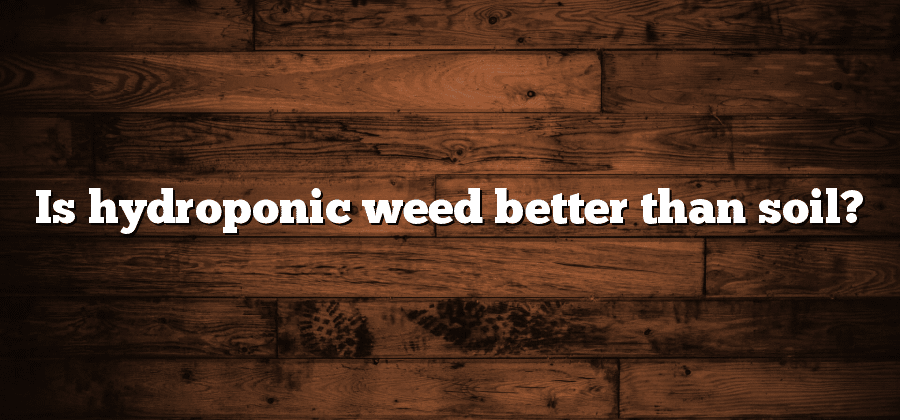Hydroponic Weed vs. Soil: Nutrient Absorption
Hydroponic cultivation is gaining popularity among weed growers due to its efficient system of nutrient absorption. Unlike traditional soil-based cultivation, hydroponics provides a controlled environment where plants directly absorb essential nutrients through water-based solutions. This method allows for precise control over the nutrient levels, ensuring that plants receive the optimal amount needed for healthy growth.
In contrast, soil-based cultivation relies on the organic matter present in the soil to provide nutrients to the plants. However, this process is less efficient as the plants have to rely on the soil’s ability to break down organic matter and release the nutrients. Factors such as soil composition, pH levels, and microbial activity can affect the availability and absorption of nutrients by the plants. As a result, there may be fluctuations in nutrient levels, potentially leading to imbalances and deficiencies in the plants’ growth.
Hydroponic Weed vs. Soil: Water Efficiency
When comparing hydroponic weed cultivation to traditional soil cultivation, water efficiency is a crucial factor to consider. One of the key advantages of hydroponics is its ability to significantly conserve water compared to soil-based methods. In hydroponic systems, water is efficiently recycled and reused, minimizing the amount of water required to sustain the plants. This is accomplished through various techniques such as recirculating the nutrient solution, controlling water delivery precisely, and preventing water loss from evaporation or runoff.
In contrast, soil-based cultivation often leads to water wastage due to ineffective irrigation practices, inefficient absorption by plants, and water runoff. Soil can easily become compacted and restrict water penetration, resulting in poor absorption and excessive watering. Additionally, excess water in soil can drain out through the bottom or evaporate, leading to unnecessary water usage. The water efficiency of hydroponic systems, on the other hand, ensures that the plants receive precisely the amount they need, using less water overall and reducing the strain on our limited water resources.
Hydroponic Weed vs. Soil: Pest Control
One of the key advantages of hydroponic weed cultivation is its superior pest control. Unlike traditional soil-based methods, hydroponic systems provide a more controlled environment that minimizes the risk of pest infestations. The absence of soil greatly reduces the chances of soil-borne pests such as nematodes, soil mites, and fungi attacking the crops. Additionally, the closed system of hydroponics prevents common airborne pests like aphids, thrips, and whiteflies from reaching the plants, further reducing the need for chemical pesticides.
With hydroponics, growers have more control over the growing conditions, allowing them to address potential pest issues more proactively. Integrated pest management techniques can be implemented more effectively, including the use of biological controls such as beneficial insects and microorganisms. This holistic approach not only reduces reliance on chemical pesticides but also promotes a healthier and more sustainable growing system. As a result, hydroponic weed growers enjoy a higher level of pest control, ensuring healthier and more productive crops while reducing the environmental impact.
Hydroponic Weed vs. Soil: Growth Rate
Hydroponic weed cultivation has gained popularity in recent years due to its potential for faster growth rates compared to traditional soil-based methods. By providing plants with a carefully controlled environment, hydroponic systems optimize nutrient absorption and minimize the amount of energy spent on root development. With a direct supply of nutrients and water, plants grown hydroponically can allocate more energy towards above-ground growth, resulting in accelerated growth rates.
On the other hand, soil-based cultivation techniques have a more varied growth rate due to the natural variability of soil conditions. While some soils may have ideal nutrient content, pH levels, and water retention capabilities, others may lack these essential factors, leading to slower growth rates. Additionally, soil-based cultivation is more prone to nutrient leaching, where essential elements get washed away or become less available to plants. However, this variability in growth rates can also be advantageous as it allows for diversity in plant development and can cater to specific soil characteristics conducive to certain crop varieties.
Both hydroponic and soil-based methods offer unique advantages and challenges in terms of growth rates. Understanding these differences is crucial for growers to make informed decisions based on their specific needs and objectives. Whether it is rapid and consistent growth with hydroponics or the flexibility and adaptation of soil-based cultivation, each method has its own merits that can contribute to successful weed production.
Hydroponic Weed vs. Soil: Quality Control
One essential aspect to consider when comparing hydroponic weed with soil-grown weed is the level of quality control. Hydroponic systems provide growers with greater control over the growing environment, enabling them to optimize conditions for plant growth. This control extends to factors such as nutrient composition, pH levels, and even lighting schedules. With the ability to fine-tune these parameters, hydroponic growers can ensure consistent and high-quality yields.
On the other hand, soil-grown weed poses certain challenges when it comes to quality control. Soil composition can vary significantly from one location to another, leading to inconsistent nutrient uptake by the plants. Additionally, soil may contain contaminants or pests that can affect the overall quality and safety of the crops. While soil growers can take measures to address these issues, such as soil testing and pest control methods, the level of control cannot match that of hydroponic systems. Consequently, maintaining a consistent level of quality becomes more challenging in soil-based cultivation.






